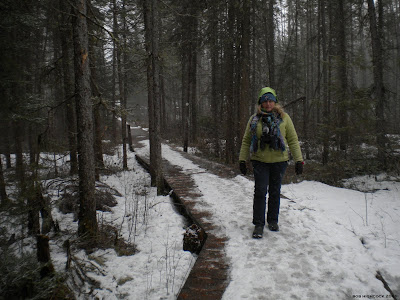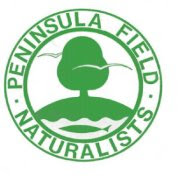As you can see, I'm slightly behind in my postings. It has been over a month since Jean and I headed north in search of Boreal species. The snow and ice are long gone and sadly, warbler migration is starting to slow down in Niagara. So bear with me. I'll soon catch up. At least that's the plan.
When I booked a room the week before the OFO Algonquin P.P. trip, Gary at the Algonquin Inn informed me that there was snow on the ground and that the lakes were still completely frozen over. Though it would take some time for the ice to melt away, the majority of the snow cover would be gone in time for our arrival the weekend of the trip.
Driving north on April 16, neither heavy rain or the 3 vehicle accident on the Burlington Skway could deter my need to tick some Boreal species. A coffee break north of Toronto refueled my energy for the rest of the drive to our destination.
Oxtongue Lake was still covered with ice.


Overnight, the precipitation returned in the form of snow and it continued to snow while we ate breakfast and observed the birds visiting the feeders. Gary and his family did a great job making sure all the guests were fed well and had plenty of time to get to the west gate of Algonquin P.P. for the start of the trip. Gary was quick to follow once all had left.

Our third OFO trip in Algonquin but the brushing of snow off the car was a first. As we were about to leave, 3 Common Ravens (FOY) flew overhead.

After a quick briefing at the park entrance, we followed trip leaders Ron Tozer and Kevin Clute to our first stop.

At Kilometre 8, no Black-backed Woodpecker on the utility poles but we heard a Winter Wren (FOY) singing in the brush across from the Tea Lake Dam entrance. I believe it to be the very same wren we heard on last year's trip.

A short stop at Smoke Creek produced a Common Loon. And yes, it was snowing.

In comparison to the previous trips, the Cache Lake stop was a disappointment. Ron suspected there would be no snipe and approached the area himself while the rest of us, including Jean and I, searched for anything resembling a bird along a nearby gravel road. No repeat Blue-headed Vireo and though Ron did flush one Wilson's Snipe, no one was there to see it.
The absence of species observed the previous year continued at the Lake of Two Rivers campground. No Pine Warbler.

Surely this unwanted trend would stop at the Spruce Bog Trail. Spruce Grouse have been observed on every trip for over 20 years but recordings of a female grouse failed to attract a male. Luckily, we did not leave the trail empty-handed. The group was able to view a Gray Jay (FOY) in a spruce tree. One Boreal species down, three to go.
Not much action at the Visitor Centre. To prevent hungry bears from gathering at the rear of the centre, seed was removed from the feeders. During our lunch break, the streak of bad luck, or more aptly described bad timing, continued. While I was returning our cooler bag to the car, a Bohemian Waxing flew by as Jean stood on the observation deck with a few members from our group. The trip just keeps getting better. No Spruce Grouse and now a missed lifer.
I thought we may still have a chance along Opeongo Road. Driving to the interior access point on Lake Opeongo, we passed boundless areas of Black Spruce forest, sedge marsh and bog habitat but the three Boreal species Jean and I sought were not found.
There was one bird that brought the line of cars to a halt. A grassland species of sparrow was foraging along the side of the road and continued its search for food despite the large audience of relieved birders.

A lifer Vesper Sparrow (#304) for Jean and I.


This bird was a lifer for a few members, including Gary our host at the Algonquin Inn. He captured an image of the bird as it stood at the side of road.
At the access point, there was little open water but it was enough for one Common Loon and two frolicking otters. A lifer bird and now a lifer mammal. Opeongo Road was not bad after all.



Continuing eastward on Highway 60, we observed a few Snow Buntings feeding on seeds found along the ice edge on Brewer Lake.
We stopped near kilometre 54 to look for Black-backed Woodpecker. The nesting season of this species occurs from late April to mid July and on previous trips we successfully found a male excavating a hole in a utility pole. But this day, the inclement weather interrupted all excavation projects.
We returned to the Spruce Bog Boardwalk and searched for grouse on both sides of Sunday Creek.


One last attempt was made along a short section of the Bat Lake Trail at kilometre 30. Not too long after starting our walk through the mixed forest (poplar, birch, spruce, and fir) fresh grouse tracks were spotted in the snow. To a non-birder, it must have been comical to see a group of adults following the meandering tracks of bird in less than spring-like weather. One wise member of our group walked along the side of the highway and was awarded the observation of a flushed Ruffed Grouse while the rest of us continued to search for the elusive bird within the forest. If I did not know they existed, I would definitely had labelled this undertaking a "snipe hunt".
Our trip ended with only one Boreal species added to the year list. The snow and occasional ice pellets certainly contributed to the missing ticks. Only Boreal Chickadee was missed last year, so this may deflate our chances of beating last year's provincial total. Jean and I may be scrambling for a few ticks towards the end of the year and a return visit to Nipissing Region could very well be in the cards.







